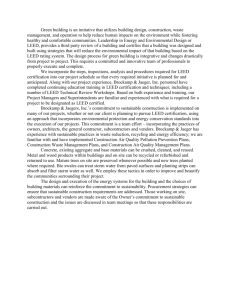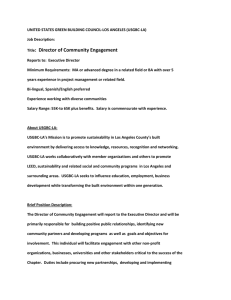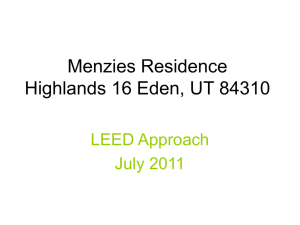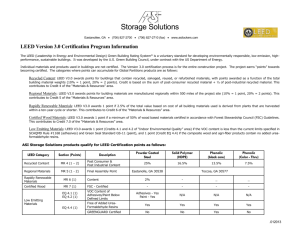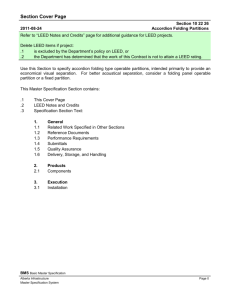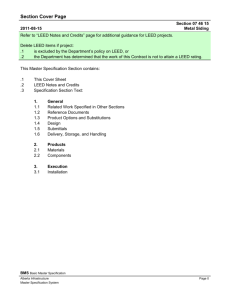Drew University Environmentally Responsible Building Guidelines
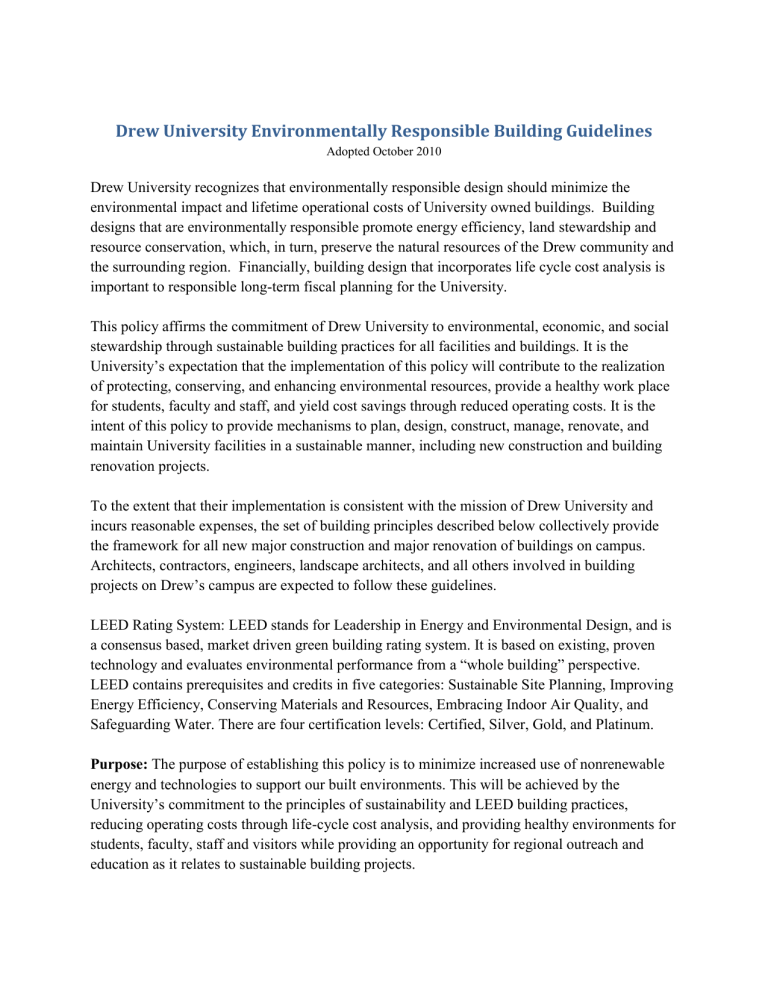
Drew University Environmentally Responsible Building Guidelines
Adopted October 2010
Drew University recognizes that environmentally responsible design should minimize the environmental impact and lifetime operational costs of University owned buildings. Building designs that are environmentally responsible promote energy efficiency, land stewardship and resource conservation, which, in turn, preserve the natural resources of the Drew community and the surrounding region. Financially, building design that incorporates life cycle cost analysis is important to responsible long-term fiscal planning for the University.
This policy affirms the commitment of Drew University to environmental, economic, and social stewardship through sustainable building practices for all facilities and buildings. It is the
University’s expectation that the implementation of this policy will contribute to the realization of protecting, conserving, and enhancing environmental resources, provide a healthy work place for students, faculty and staff, and yield cost savings through reduced operating costs. It is the intent of this policy to provide mechanisms to plan, design, construct, manage, renovate, and maintain University facilities in a sustainable manner, including new construction and building renovation projects.
To the extent that their implementation is consistent with the mission of Drew University and incurs reasonable expenses, the set of building principles described below collectively provide the framework for all new major construction and major renovation of buildings on campus.
Architects, contractors, engineers, landscape architects, and all others involved in building projects on Drew’s campus are expected to follow these guidelines.
LEED Rating System: LEED stands for Leadership in Energy and Environmental Design, and is a consensus based, market driven green building rating system. It is based on existing, proven technology and evaluates environmental performance from a “whole building” perspective.
LEED contains prerequisites and credits in five categories: Sustainable Site Planning, Improving
Energy Efficiency, Conserving Materials and Resources, Embracing Indoor Air Quality, and
Safeguarding Water. There are four certification levels: Certified, Silver, Gold, and Platinum.
Purpose: The purpose of establishing this policy is to minimize increased use of nonrenewable energy and technologies to support our built environments. This will be achieved by the
University’s commitment to the principles of sustainability and LEED building practices, reducing operating costs through life-cycle cost analysis, and providing healthy environments for students, faculty, staff and visitors while providing an opportunity for regional outreach and education as it relates to sustainable building projects.
It is the policy of Drew University to finance, plan, design, construct, manage, renovate, and maintain its facilities in a sustainable fashion. This applies to new construction and major renovations in which they the criteria given. The most recent edition of the US Green Building
Council’s LEED rating system and accompanying Reference Guide shall be used as a design and measurement tool to determine what constitutes a sustainable building by national standards. All new facilities over 5,000 gross square feet and major capital renovations costing more that 50% of building replacement value shall meet and acquire a LEED Silver rating at a minimum.
Particular emphasis is to be directed toward the project’s ability to optimize energy performance, utilize advanced commissioning practices and measurement and verification standards as outlined by the USGBC.
All University divisions, departments and offices and their contractors responsible for financing, planning, designing, developing, constructing, renovating and managing University owned facilities and buildings regardless of location will comply with this policy.
Drew University expects those involved in building projects on campus to:
Require that all new construction is built to LEED Silver standard or equivalent; as part of the American College and University President’s Climate Commitment (ACUPCC).
Particular attention should be directed toward the project’s ability to optimize energy performance, utilize advanced commissioning practices and measurement and verification standards as outlined by the USGBC. The project team should always incorporate best management energy efficiency practices when appropriate and strive to exceed LEED silver standards within the appropriate rating category.
Evaluate each building project individually for pursuing LEED ratings beyond the
“silver” level. Architects and contractors should sustain a dialogue with University representatives when choosing which LEED points (i.e. environmentally responsible features) to pursue.
Include an architect on the design team with environmentally-responsible design experience and are LEED Accredited Professionals as architects with these credentials provide experience with the LEED certification process and facilitate efficient incorporation of environmentally responsible technology into building design.
Evaluate a building’s lifecycle costs in addition to initial construction costs. The total cost of ownership, and not simply the initial cost, must be evaluated for all major building projects. Architects and engineers are expected to provide life cycle cost estimates of building systems during the earliest phase of building design. The university is
particularly interested in receiving lifecycle cost estimates throughout the design process for the building envelope as well as the HVAC, lighting, and water systems.
Use appropriate resource conservation technology to improve water and energy efficiency beyond industry baseline. Energy conservation should be looked at as a priority and the project team should strive to exceed LEED silver standards within the appropriate rating category.
Present for consideration, building features which reduce environmental impact even if they have no economic payback. The University is willing to consider the building features impact that have no direct economic payback but reduce the negative environmental impact of the building. Examples of this type of building feature include: native landscaping, using building materials made of recycled content, and limiting storm water runoff.
Use innovative technology only when a particular technology has proven itself reliable in a similar climate. The University assumes all liabilities for campus buildings and seeks to limit the risks associated with ownership by using only reliable technologies specific to the University’s situation.
Recycle construction debris from both new construction and remodeling projects in an effort to minimize the waste that is sent to the landfill. All construction contractors must have plans for reducing construction waste prior to start of project.
Conduct commissioning of the building energy systems throughout the design and construction process to ensure optimal efficiency.
In addition to vertical construction projects, the University is committed to utilizing sustainable design and construction methods as appropriate for scope, scale and impact of all horizontal projects, including but not limited to: parking lots, landscaping, and utility/infrastructure work.
When relevant and feasible, Drew University will utilize the sustainable building design and construction process as a tool for teaching and learning within our community
(students, faculty, staff, and the surrounding region). Our projects will serve as models and provide a mechanism for outreach for broader social engagement within the region.
Responsibility: All University employees shall be responsible for ensuring that projects and facility use are implemented so as to comply with the purpose of this policy. The Facilities
Project Management Office shall be responsible for evaluating and documenting the applicability
of all University design, construction, renovation and horizontal projects in meeting the goals of this policy. The President or his/her designee has final authority to determine the appropriate level of applicability of this policy.
This policy is to be reviewed every three years, and revised as appropriate based on the emerging opportunities for enhanced project implementation in regards to energy and resource efficiency.



